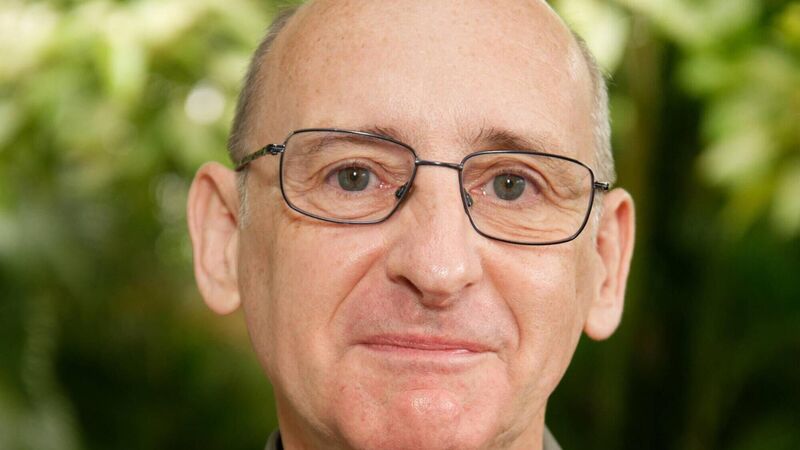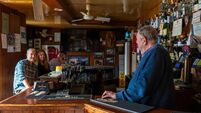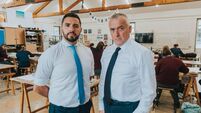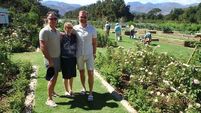My grandfather was a Ballycotton pirate!

Tom Mahon, author of The Ballycotton Job.
THE author of a book about what has been described as “the most astonishing act of piracy carried out in Ireland in the last 200 years”, the capture of the British war ship the Upnor, was delighted to give an illustrated talk at the Sea Church, Ballycotton recently.
Tom Mahon, author of The Ballycotton Job: An Incredible True Story Of IRA Pirates, described it as “like a home-coming”.
“It was terrific to come back here and meet people whose relatives were involved,” he said.
“Sometimes, they were not always aware of the involvement, which is interesting. One of the best aspects of writing the book is that since publication, I’ve met so many fabulous, kind and interesting people in east Cork.
“There is huge local interest in the book and there were around 1,000 people in east Cork who were involved in the Ballycotton Job.”
In the incident in March, 1922, the IRA commandeered a tugboat from the Royal Navy base at Queenstown. Simultaneously, over 80 trucks and lorries were hijacked all across Cork.
The IRA squad captured arms ship Upnor, bringing it into the small port of Ballycotton. The village, now under IRA control, witnessed the unloading of weaponry onto waiting lorries then driven off to secret arms dumps throughout Cork.
“In Ballycotton, before and after the talk, I chatted with some great people, some of whom had family memories of the Ballycotton Job and the capture of the Upnor. Researching and writing The Ballycotton Job was fun even though the subject was complex. The book was 13 years in the making.”
This is the forgotten story of one of the most incredible and dramatic adventures that took place in Cork. The incident astounded the citizenry of Ballycotton, shocked Michael Collins, threw the British government into disarray, and changed the course of the Irish Civil War.
No wonder Winston Churchill said in amazement, “the Irish have a genius for conspiracy”.
Tom didn’t grow up in Cork, but has a strong connection to the area and its history.
“I was born in Liverpool and I grew up in Dublin,” he said. His grandfather Tom Crofts was one of the Ballycotton pirates.
“I have fond childhood memories of going to Fountainstown on holidays where my grandparents had a holiday cottage. I remember the harbour and Crosshaven. I graduated from UCC in 1983 as a doctor and I moved to the USA in 1989.”
Tom, who is now retired, went on to complete his postgraduate studies in Boston, where he was a member of the Medical Faculty at Harvard Medical School. He is married to Margaret, who is from Hawaii. The couple live in Honolulu and they have a son, Tommy, 24, who lives in Paris.
“Tommy is learning to speak Irish! He is very fussy and he asked his pals what dialect he should learn and they told him to learn the Munster dialect. My wife loves Ireland. She enjoys the people and their humour. I often hear the Dublin accent when she tunes into RTÉ on the internet.”
Margaret has often accompanied Tom to Cork.
“We love the food here, the fresh breads, the butter and cream; everything is so fresh. We enjoy quality foods.”
But there was another big draw for Tom.
“I had to come back to Cork for the story,” he said. “There is no mention of the Upnor in books. The story had to be told. It was an incredible escapade. There is lots of local interest in it.”
Writing the book was a challenge, but one he relished.
“Researching and writing this book has been a most enjoyable marathon, over the course of which I’ve visited numerous archives and historical sites. The project came together one piece at a time until I ended up uncovering far more information than I ever expected.”
During the course of his extensive research, Tom discovered something else.
“One thing I can attest to is that the truth is indeed stranger than fiction.”
What did he set out to achieve?
“I wanted to tell the story to draw people in; a story, not a historical document. I engaged with it so I wanted to tell it. Writing the book indulged me in a passion,” he said.
“I’ve endeavoured not just to tell a fascinating adventure story, but also to peel away the layers that obscure the under-lying characters, to look at the nature of violence and prejudice, to cast light on the subjectivity of views on morality and justice and to consider the difficulty of distinguishing perpetrators from the victims and vice versa.
“Where possible, I’ve given the full names of fatalities, even if their deaths are only mentioned in passing, in order to commemorate their lives and the tragedy of their deaths.
“Colonialism and the attitudes associated with it play an important role in this narrative and likewise I believe they were significant factors in the War of Independence that remain under-appreciated to this day.”
Tom’s research put him in touch with many people.
“I’m deeply indebted to countless archivists, librarians, local historians and experts,” he said. “To all of those whom I’ve inadvertently failed to acknowledge, I sincerely apologise.
“I’m especially grateful to two outstanding historians for sharing their knowledge, insights and time; Dr John Borgonovo of UCC and Proffesor Peter Hoffenberg of the University of Hawaii.
“I was delighted to make contact with the descendants of some of the participants; some of whom I met in Ballycotton. It’s been a pleasure meeting Len Williams, grandson and namesake of the captain of The Warrior. I’m grateful to Len for sharing a trove of documentation and images about his grandfather, a brave and skilful tugboat captain who saved scores of lives during the First World War.”
How did the story; the incredible true story of IRA pirates come about?
“The story would never have occurred were it not for the brilliant Captain Jeremiah Collins, a true Irish patriot - and so it was terrific to hear from his great-great granddaughter Rachel Wheeler and her mother Noreen Kinney. I appreciate being able to look at their fabulous collection of photographs and newspaper clippings.”
Tom was fortunate to correspond with Bob Long and David Kerr, two experts on historic tugboats.
“Len and I visited the Challenge, a restored steam tugboat in Southampton, where we spent the day with David. This was one of the highlights of my research,” Tom said.
“The ‘Challenge is a beautiful vessel.’
Tom acknowledges many more maritime experts in the book.
Who does the book appeal to?
“I think it appeals to so many general readers,” says Tom.
“People of all ages and gender enjoyed the book. It reached out to people. I’ve gotten wonderful feedback. The Ballycotton Job is in it’s third printing. It has exceeded all expectations.”
Ballycotton, often referred to as a hidden gem, appeals to Tom.
“It is a fantastic area,” says Tom.
Would he like to live in east Cork?
“Perhaps. But the sun always shines in Honolulu!”
The Ballycotton Job, by Tom Mahon, published by Mercier Press. Available now.







 App?
App?


